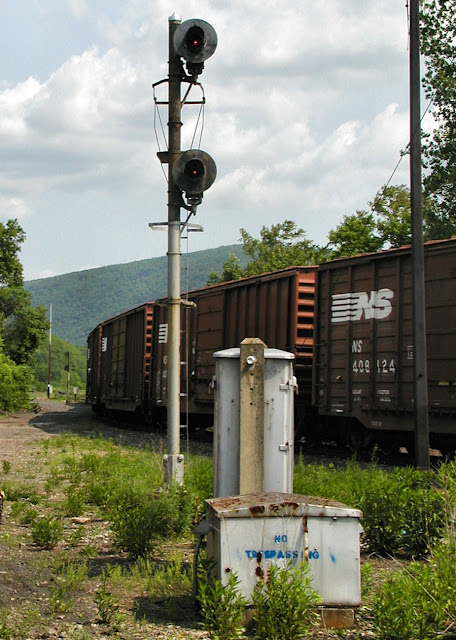As the smell of pumpkin space fills the coffee shoppes and the foliage begins to change colors, I figured I'd do a little Halloween themed post about zombie and phantom signals. While I may have touched on this topic as part of other posts, apparently I never gave zombies and phantoms a dedicated post so here you go. Zombie signals are signals that exist, but govern a track that does not and phantom signals exist within the interlocking logic, but not in real life. Both appear where interlockings are having bits and pieces removed with zombies being out in the field and phantoms on the interlocking machine or other user interface. However in both cases the signal must still wired into active signaling infrastructure so a signal standing aside a completely removed rail line is not a zombie and a signal lever painted white as a spare is not a phantom.
 |
| 2W zombie mast at CP-LEHIGHTON |
The best example of a zombie signal was the 2W small target searchlight mast at CP-LEHIGHTON on the former Conrail Lehigh Line. Located at the point where a connection to the old CNJ Main Line was plugged into the old Lehigh Valley Main Line, CP-LEHIGHTON came about when the staffed tower was closed and Conrail created a single main line from the best parts of each predecessor roads. Governing a stub industrial track on the route of the old LVRR main, industry closures eventually made the industrial track surplus to requirements between 1992 and 1997. However Conrail faced non-trivial costs to alter the interlocking, especially since the signal had bulb out protection. Their solution was to leave the signal in place with the searchlight bulbs in a low power mode.
 |
| Remains of 76LA after the signal was finally removed. |
Another good example is the 76LA dwarf signal at DOWNS interlocking on the PRR Main Line. Again, this governed an industrial track that was eventually removed from service, but once again it was cheaper to leave the signal in place.
 |
| Zombie CPL at LAUGHLIN JCT in 2009 |
I recall reading that the eastbound signal for passenger traffic to Pittsburgh's B&O Station at LAUGHLIN JCT became a zombie after the rail service was discontinued. While the mast was still there in 2009, a partial re-signaling in 2003 may have finally extinguished the lamps.
 |
| Does the 10RB signal from nowhere count? |
Now one minor distinction are signals where the tracks have been cut just past the insulated joint and signals that are just floating out in the middle of nowhere. PAOLI tower's Hill Track 10RB signal went on this journey first standing next to the end of track and later standing next to nothing. While standing next to cut track isn't quite as "zombie" as standing next to nothing, I'm not going to nitpick.
 |
| Track 2 signal is still lit over an empty roadbed. |
Another interesting zombie signal situation was on the removed #2 track on the same PRR Main Line between CALN interlocking and PARK tower. This track was removed around 2010 and featured 3 zombie intermediate signal locations for the better part of a decade. In this case in addition to having to modify the old 504 CTC system controlled by THORN tower, Amtrak also was able to put off having to do the regulatory process of discontinuing that track's signal system, even if the track did not physically exist.
Sidings exit signals are another common source of zombie signaling as industrial closures can lead to siding removal by MoW forces while the related signaling is left in place until the signal department decides to deal with it.
 |
| MIDLAND interlocking in Gainesville featured a zombie derail. |
The final type of zombie signal I should mention is removed diamond crossings. These are expensive to maintain and while often the diamond is removed with the tracks and signals on either side remaining, its not unheard of for the entire crossing line to be torn up except for the signals which may be the property/responsibility of the surviving route. I can't currently find my example of a zombie diamond signal, so I posted a zombie derail instead.
Examples of phantom signals are a bit harder to document and were largely the product of mechanical interlocking where changes in the physical plant would require extensive physical modifications to the physically implemented interlocking logic. In certain locations it made more sense to leave the unused levers in place where the operator would still have to line them as if they were still in the field. While I am aware of phantoms also existing in relay based interlocking plants, the only example I can currently come up with is the late great ALTO tower in Altoona, PA. When the layout was modified in the 1980's, several signals in the east end of the plant were converted into phantoms, specifically the 20L, 34R and 38R, as they crossovers they had protected had been removed. On the model board the signals existed (labeled phantom), but it would not be possible to hold a train at one.
In summary, far from being scary, zombie and phantom signals are a neat little quirk that occurs at the intersection of abstract logic and the real world.





No comments:
Post a Comment